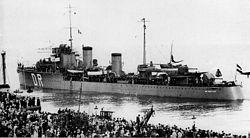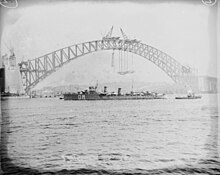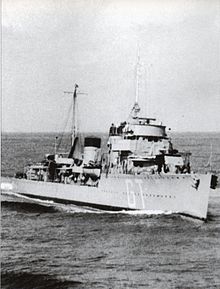Mr. Ms. Van Ghent (1926)
|
Mr. Ms. Van Ghent still as Mr. Ms. De Ruyter
|
||||||||||||||||||||||
|
||||||||||||||||||||||
|
||||||||||||||||||||||
|
||||||||||||||||||||||
|
||||||||||||||||||||||
The Mr. Ms. Van Ghent (actually Hr. Ms. torpedo boat Jager Van Ghent , often called HNLMS Van Ghent called) was a Dutch destroyer of Admiral class , the 1929 Hr. Ms. De Ruyter ( Mr. Ms. Torpedobootjager De Ruyter , after Admiral Michiel de Ruyter ) was commissioned with the Royal Netherlands Navy and was renamed Van Ghent in 1934 . After renaming it was the second after the Admiral Willem van Ghent named warship of the Dutch Navy. The destroyer served in the waters of the Dutch East Indies and subsequently took part in the Pacific War from 1941 .
Due to a navigation error, the Van Ghent was stranded on February 15, 1942 as the first destroyer in the Dutch fleet to be lost in the war against Japan. Because of the early loss, the ship could no longer play a major role in the fighting.
history
In the mid-1920s, the Netherlands wanted to procure four modern destroyers for use in their East Indian colonial empire. The newbuildings were ordered from Dutch shipyards based on a design by the British Yarrows shipyard , which based on a very similar design, the Ambuscade, one of the prototypes for the future destroyers of the British Royal Navy from 1924 to 1927.
The new buildings in the Netherlands received four 120 mm cannons, the same main armament as the new British buildings. However, they were weapons from the Swedish manufacturer Bofors , which were built under license in the Netherlands. Two each were arranged overlapping at the bow and stern. Two 75 mm anti-aircraft guns , which were installed at the same height on a platform between the chimneys, were of the same origin . The anti-aircraft weaponry supplemented four heavy 12.7 mm machine guns of the type Browning on the sides of the bridge house. To repel submarines, the destroyers were equipped with twelve depth charges and four launchers. In addition there was the armament with six 533 mm torpedo tubes , which were installed one behind the other amidships in two sets of triple behind the funnels and in front of the rear deckhouse with the raised stern cannon.
The ships were prepared for use as mine layers. For such an operation, they were given two rails from the rear deckhouse to the drop hatches just before the stern. It could not be determined whether other weapons had to be surrendered during an operation with up to 24 mines. At least the rear rifle could not be used in this case.
A special feature of the Dutch destroyers was their equipment with an aircraft for reconnaissance purposes. For the transport of a Fokker C.VII-W floatplane, they had a platform above the rear torpedo tube set between the headlight platform between the tube sets and the rear deckhouse., On the headlight platform there was a mast with a cargo boom to help the aircraft take off to sit on the water or get back on board.
The destroyer De Ruyter (later Van Ghent ) was laid on August 28, 1925 as the fourth and last of the first group of the admiral class and the only one near de Schelde in Vlissingen and was launched on October 23, 1926 as De Ruyter as the first ship of the class from the stack. On May 31, 1928, the ship was put into service as the second ship of the class.
First missions
De Ruyter left the Netherlands on September 27, 1928 with the sister ship Evertsen to be used in the Dutch East Indies . At the end of July 1929, the two destroyers sailed with the cruiser Java and two submarines from Surabaya to Tanjung Priok to receive the King of Siam on his yacht Maha Chakri , accompanied by the destroyer Phra Ruang (ex HMS Radiant ), who served the Dutch Visited colony. Subsequently, the cruiser and the two destroyers toured large parts of the Dutch territory and then took part in a naval parade in Tanjung Priok on August 31 in honor of the birthday of the Dutch Queen Wilhelmina . During an exercise by the cruiser Sumatra with the destroyers De Ruyter and Evertsen and five submarines, the cruiser ran aground on May 14, 1931 near the island of Madura on an underwater rock not shown in the sea charts. The destroyers secured the cruiser until after three days it was recovered by the gunboat Soemba and a tug.
On October 1, 1934, destroyer De Ruyter was in Mr. Ms. Van Ghent renamed because a new light cruiser was on the pile in the Wilton Fijenoord shipyard , which was to be given the traditional name De Ruyter . Like almost all of her sister ships, Van Ghent continued to serve in the Dutch East Indies on October 1, 1934 and later participated in World War II and the Pacific War.
War effort
During the German invasion of the Netherlands in May 1940, the Van Ghent and the sister ship Kortenaer occupied five German merchant ships in the Dutch East Indies. In 1941 the Van Ghent became part of the ABDA fleet and fought after the declaration of war by the Japanese Empire on the Netherlands with British , Australian and US warships against the invasion of the European colonies in the region. Due to the early loss, however, the ship could no longer play a major role in the fighting.
The destroyer fought on February 4, 1942 at the battle of the Makassar Strait not far from Kangean against Japanese dive bombers , with their anti-aircraft guns succeeding in shooting down at least one of the attacking machines.
The Van Ghent was subsequently involved in the salvage of two US ships. First she came to the aid of the US steamer USAT Liberty (6211 GRT), which had been badly damaged by the Japanese submarine I-166 ( Corvette Captain Yoshitome) with the US destroyer USS Paul Jones, and towed it away. However, due to the severe damage to the north-eastern coast of Bali near Tulamben , it had to be put on the ground, where it later capsized and was abandoned. The other ship was the damaged USAT Liberty Glo troop carrier , which was also being towed away .
On February 15, 1942, the Van Ghent was involved in the attack on the convoy to Palembang , where she was on position 3 on the way to the combat area due to a navigation error in the Pride Road at Bamidjo Reef between Banka (today: Muntok ) and the island of Billiton ° 5 ′ S , 107 ° 21 ′ E stranded and had to be abandoned due to the severe damage suffered. There were no personnel losses in this accident, as the destroyer Bankert was able to take over the crew.
The shipwreck was the first loss of a ship for the ABDA fleet. One consequence was that the ABDA fleet, which was already inferior from the start, was unnecessarily weakened from the start.
The sister ships of the Van Ghent
The De Ruyter / Van Ghent formed the first group of the admiral class with the following three destroyers:
| Surname | Shipyard | Launch | in service | Final fate |
|---|---|---|---|---|
| Evertsen | Burgerhout Rotterdam |
12/29/1926 | 04/12/1928 | Sunk on 01.03.1942 |
| Cortenaer | Burgerhout | April 2, 1927 | September 3, 1928 | Sunk 02/27/1942 |
| Piet Hein | Burgerhout | 06/30/1927 | 01/25/1929 | 19.02.1942 sunk |
Remarks
- ↑ Internationally, the prefix HNLMS (His / Her Netherlands Majesty's Ship) is common for units of the Dutch Navy. The Navy itself uses the prefixes Zr. Ms. (Zijner Majesteits) in the reign of a king, and Mr. Ms. (Harer Majesteits) with a queen
literature
- MJ Whitley: Destroyer in World War II. Motorbuchverlag, Stuttgart 1991. ISBN 3-613-01426-2
Web links
- Admiral class at netherlandsnavy.nl (English)
- Jürgen Rohwer, Gerhard Hümmelchen: Chronicle of the naval war 1939-1945. Ed. Library for Contemporary History / Württemberg State Library Stuttgart, 2007–2017


